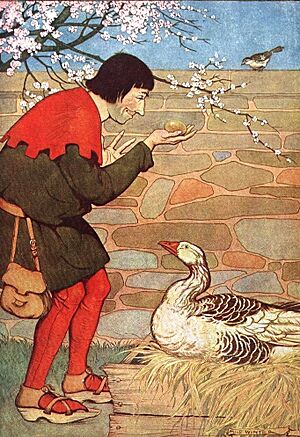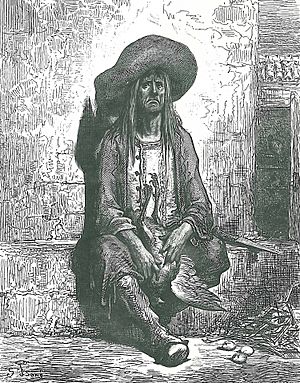The Goose that Laid the Golden Eggs facts for kids
"The Goose that Laid the Golden Eggs" is a famous story from Aesop's Fables. Aesop was an ancient Greek storyteller known for his short tales that teach a lesson. This particular story is about a special bird that lays golden eggs. Many versions of this tale exist, sometimes featuring a hen or other birds instead of a goose. The story has given us a popular saying: "killing the goose that lays the golden eggs." This phrase means destroying something valuable because you are too greedy or impatient.
Contents
What is the Story About?
The story usually tells of a farmer or a couple who own a goose (or a hen) that lays one golden egg every day. This was an amazing gift, making them rich little by little. However, they became very greedy. They thought, "If the goose lays golden eggs, it must have a lot of gold inside!"
The Farmer's Big Mistake
Driven by their desire to get all the gold at once, they decided to kill the goose. They hoped to find a huge lump of gold inside its body. But when they killed the goose, they found nothing special. It was just like any other goose. By trying to get rich too quickly, they lost the daily golden egg that was making them wealthy. They ended up with nothing.
What is the Moral of the Story?
The main lesson of "The Goose that Laid the Golden Eggs" is about greed. It teaches us that being too greedy can make you lose everything you have. If you are not patient and try to get too much too fast, you might destroy the very thing that helps you.
- Greed loses all by striving all to gain. This means that when you are too greedy and try to get everything, you often end up with nothing.
- Much wants more and loses all. This highlights how wanting more and more can lead to losing what you already have.
The English saying "Kill not the goose that lays the golden egg" comes directly from this fable. It warns against actions that destroy a valuable source of income or benefit due to short-sightedness or impatience.
Similar Stories from Around the World
The idea of a golden egg-laying bird is not just in Aesop's Fables. Similar stories can be found in other cultures, especially in the East.
The Golden Swan in India
In ancient India, there is a Buddhist story called the Suvannahamsa Jataka. In this tale, a poor family's father is reborn as a swan with golden feathers. He tells his family to pluck one golden feather at a time to sell and support themselves. He would return often to give them more. But the mother became greedy. She plucked all the feathers at once, hoping for more money. However, the feathers turned into ordinary ones. When the swan's feathers grew back, they were no longer gold.
The lesson from this story is similar:
Contented be, nor itch for further store.
They seized the swan – but had its gold no more.
This means it's better to be happy with what you have and not always want more.
Ancient Art and Modern Films
The story of the golden goose has inspired many artists and filmmakers over time.
Artistic Interpretations
Many drawings and paintings show the farmer looking sad after realizing he made a big mistake by killing the goose. The American artist Thomas Nast used this fable in a political cartoon in 1878. The cartoon showed a confused farmer, representing union members, being advised by a "Communistic Statesman." It warned against actions that could harm the economy.
Golden Egg Movies
The idea of a bird laying golden eggs has also appeared in movies:
- Golden Yeggs (1950): This was a cartoon by Warner Bros. that used the golden egg idea in a funny way.
- The Million Dollar Duck (1971): A Walt Disney movie where a duck lays golden eggs, causing lots of funny problems.
- Assia and the Hen with the Golden Eggs (1994): A Russian comedy that looks at jealousy in a small village after the Soviet Union ended.
Images for kids
ca:Llista de còmics de Mortadel·lo i Filemó#La gallina de los huevos de oro
See also
 In Spanish: La gallina de los huevos de oro (fábula) para niños
In Spanish: La gallina de los huevos de oro (fábula) para niños




